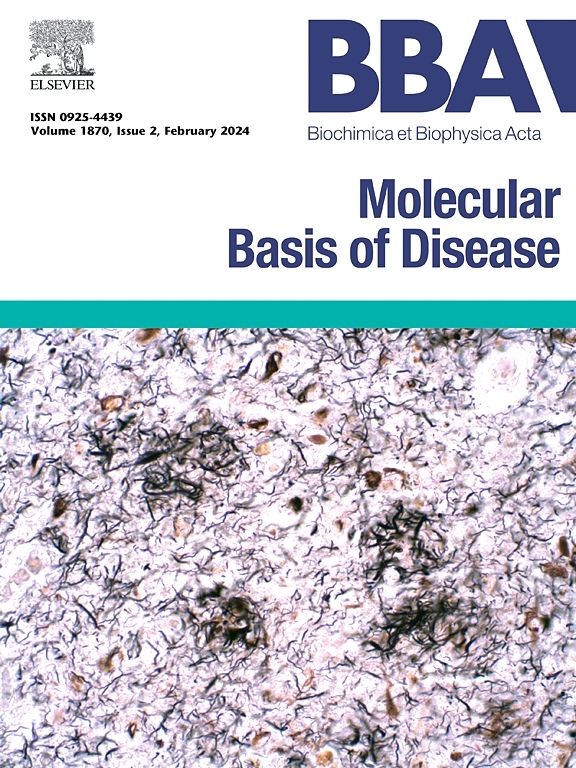代谢功能障碍相关脂肪变性肝病(MASLD)早期慢性体外模型的建立与表征
IF 4.2
2区 生物学
Q2 BIOCHEMISTRY & MOLECULAR BIOLOGY
Biochimica et biophysica acta. Molecular basis of disease
Pub Date : 2025-05-03
DOI:10.1016/j.bbadis.2025.167886
引用次数: 0
摘要
代谢功能障碍相关脂肪变性肝病(MASLD)是一种慢性进行性肝病,其全球负担日益加重,始于早期的单纯性脂肪变性(MASL),经常发展为肝硬化和肝细胞癌(HCC)。尽管MASL或脂肪变性期广泛发生,但其特征是肝脏中脂肪堆积过多,被认为是可逆和良性的,尚未得到广泛研究。为了有效地研究MASL,有必要建立一个临床相关的模型系统,该模型系统仅关注脂肪变性,以进行性和时间依赖性的方式,概括与人类疾病相关的分子变化。我们用低剂量脂肪酸混合物处理的原代永生化人肝细胞系建立了MASL的慢性细胞模型。该模型模拟慢性疾病进展模式,表现出最小的脂肪毒性,表现出进行性脂质积累(从早期到中度脂肪变性),并表现出大脂肪变性,这是MASL的一个标志。为了确定该模型是否概括了脂肪变性的形态学和分子方面,我们测量了在最近可用的早期MASL患者数据集以及非人类MASL灵长类模型中发现的关键基因和通路的表达失调。为了支持我们模型的相关性,我们观察到脂肪酸摄取、脂肪生成、线粒体活性、代谢重连接和自噬改变的增加,这些与人类和非人类灵长类动物MASL的病理特征显著重叠。总之,我们建立了一个相关的脂肪变性细胞模型,可以作为一个强大的平台,筛选现有的化学文库,以确定MASL的有效抑制剂,并通过机制研究与MASLD早期相关的改变的分子特征来发现新的治疗靶点。本文章由计算机程序翻译,如有差异,请以英文原文为准。

Generation and characterization of a chronic in vitro model to study the early stage of metabolic dysfunction-associated steatotic liver disease (MASLD)
Metabolic dysfunction-associated steatotic liver disease (MASLD) is a chronic and progressive liver disease with an increasing global burden that starts with an early stage of simple steatosis (MASL) which frequently progresses to liver cirrhosis and hepatocellular carcinoma (HCC). Despite its widespread occurrence, the MASL or steatotic stage, characterized by excessive fat accumulation in the liver and considered reversible and benign, has not been extensively studied. To study MASL effectively, it is imperative to have a clinically relevant model system that focuses solely on steatosis, in a progressive and time-dependent manner, recapitulating molecular changes associated with human disease. We established a chronic cellular model of MASL using a primary immortalized human hepatocyte cell line treated with a low dose mixture of fatty acids. This model mimics the pattern of chronic disease progression, shows minimal lipotoxicity, exhibits progressive lipid accumulation (from early to moderate steatosis), and demonstrates macrosteatosis, a hallmark of MASL. To determine whether this model recapitulates both morphological and molecular aspects of steatosis, we measured the expression of key genes and pathways found to be dysregulated in a recently available early MASL patient dataset as well as a non-human primate model of MASL. In support of the relevance of our model, we observed increased fatty acid uptake, lipogenesis, mitochondrial activity, metabolic rewiring, and autophagic alterations that significantly overlap with the pathological features of human and non-human primate MASL. In conclusion, we generate a relevant cellular model of steatosis that can serve as a robust platform for screening of existing chemical libraries to identify potent inhibitors of MASL as well as discovering novel therapeutic targets by mechanistically studying altered molecular signatures associating early stages of MASLD.
求助全文
通过发布文献求助,成功后即可免费获取论文全文。
去求助
来源期刊
CiteScore
12.30
自引率
0.00%
发文量
218
审稿时长
32 days
期刊介绍:
BBA Molecular Basis of Disease addresses the biochemistry and molecular genetics of disease processes and models of human disease. This journal covers aspects of aging, cancer, metabolic-, neurological-, and immunological-based disease. Manuscripts focused on using animal models to elucidate biochemical and mechanistic insight in each of these conditions, are particularly encouraged. Manuscripts should emphasize the underlying mechanisms of disease pathways and provide novel contributions to the understanding and/or treatment of these disorders. Highly descriptive and method development submissions may be declined without full review. The submission of uninvited reviews to BBA - Molecular Basis of Disease is strongly discouraged, and any such uninvited review should be accompanied by a coverletter outlining the compelling reasons why the review should be considered.

 求助内容:
求助内容: 应助结果提醒方式:
应助结果提醒方式:


